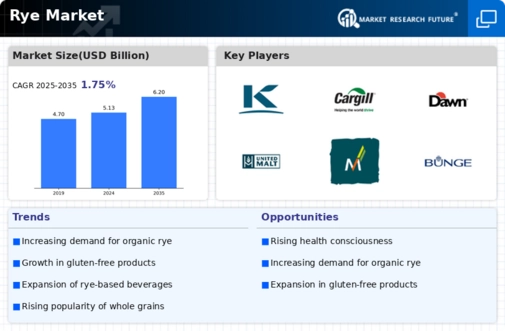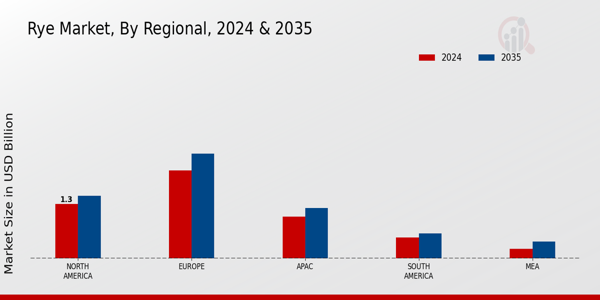Global Trade Dynamics
Global trade dynamics play a crucial role in shaping the Global Rye Market Industry. Changes in trade policies, tariffs, and international demand can significantly impact rye prices and availability. For instance, countries that produce rye may experience fluctuations in export opportunities based on global market conditions. As nations seek to diversify their grain imports, the demand for rye may increase, particularly in regions where wheat is less viable. This evolving landscape suggests that trade dynamics will continue to influence the Global Rye Market Industry, potentially leading to new market opportunities.
Market Growth Projections
The Global Rye Market Industry is poised for growth, with projections indicating a market value of 5.13 USD Billion in 2024 and an anticipated increase to 6.2 USD Billion by 2035. This growth trajectory suggests a compound annual growth rate (CAGR) of 1.74% from 2025 to 2035. The increasing awareness of rye's health benefits, coupled with rising consumer demand for sustainable and nutritious food options, is likely to drive this expansion. As the market evolves, stakeholders must remain attuned to these trends to capitalize on emerging opportunities.
Health Benefits of Rye Consumption
The health benefits associated with rye consumption are significantly influencing the Global Rye Market Industry. Research indicates that rye may aid in weight management, improve digestive health, and reduce the risk of chronic diseases. As consumers become more health-conscious, the demand for rye products is likely to increase. The market is projected to grow at a CAGR of 1.74% from 2025 to 2035, reflecting the sustained interest in rye as a nutritious grain. This trend underscores the importance of promoting the health benefits of rye to further stimulate growth within the Global Rye Market Industry.
Sustainable Agricultural Practices
Sustainable agricultural practices are increasingly influencing the Global Rye Market Industry. Farmers are adopting eco-friendly methods, such as crop rotation and reduced pesticide use, to enhance soil health and yield. Rye, being a hardy crop, requires fewer inputs and is resilient to adverse weather conditions, making it an attractive option for sustainable farming. This shift not only supports environmental goals but also aligns with consumer preferences for sustainably sourced products. As the market evolves, the integration of sustainability into rye cultivation is likely to bolster its appeal, potentially driving growth in the Global Rye Market Industry.
Rising Demand for Rye-Based Products
The Global Rye Market Industry experiences a notable increase in demand for rye-based products, driven by consumer preferences for healthier and more nutritious food options. Rye, known for its high fiber content and lower glycemic index compared to other grains, is gaining traction among health-conscious consumers. This trend is reflected in the growing popularity of rye bread, which is often perceived as a healthier alternative to wheat bread. As of 2024, the market value is projected to reach 5.13 USD Billion, indicating a robust consumer shift towards rye products. This demand is expected to sustain growth, contributing to the overall expansion of the Global Rye Market Industry.
Technological Advancements in Crop Production
Technological advancements in crop production are reshaping the Global Rye Market Industry. Innovations such as precision agriculture, genetically modified organisms, and advanced irrigation techniques are enhancing rye yields and quality. These technologies enable farmers to optimize resource use and improve crop resilience, thereby increasing profitability. As the industry adapts to these advancements, rye production is expected to become more efficient, contributing to a projected market value of 6.2 USD Billion by 2035. This growth reflects the potential of technology to transform the Global Rye Market Industry and meet the rising demand for rye products.









